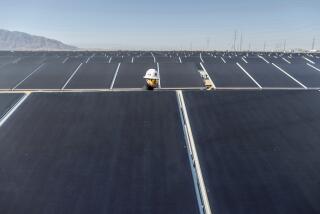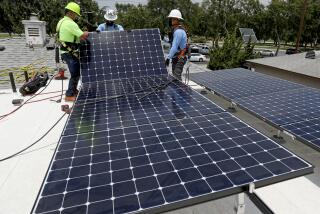Letters: Illuminating solar
Re “Small-scale solar’s big potential untapped,” Dec. 29
The story touting the potential benefits of rooftop and other smaller solar power arrays was well written and informative. Now it’s time to look under the rocks.
The Times reports that the tiny Mojave Desert town of Nipton, Calif., is off the grid. So exactly where does the electrical power come from when it’s cloudy and when the sun goes down? Generators? Batteries? What’s the (environmental) good, bad and evil of those systems? What’s their life-cycle cost for housing, fuel, maintenance, repair and replacement? Is the cost of converting direct-current battery power via expensive inverters to usable alternating-current power accounted for separately?
I am all for implementing solar and wind power if it’s done responsibly and the total amortized cost for an integrated system is transparent. Off-the-grid solar arrays are only one part of the system.
John F. Hill
Huntington Beach
Kudos for the Dec. 29 installment of your “The Solar Desert” series. The national media have turned a blind eye to the ecological atrocities and corporate favoritism constituting our nation’s move toward renewable energy in the southwestern deserts.
We can have renewable energy that will be more efficient, cost less and, most important, cause less ecological damage than our current efforts that rely on large-scale renewable power plants. There is simply no good reason why smaller projects located in areas already connected to the power grid and utilizing existing infrastructure are not part of our plan.
The multiple projects already underway threaten to destroy large parts of these fragile environments. And along with each new wind or solar plant will come miles of roads and fences, effectively barring we the people from our own public land. We deserve better than business as usual.
Cyrus Lemmon
Joshua Tree, Calif.
ALSO:
Letters: Resignation of EPA chief
Letters: An over-prescribed drug crisis?
Letters: Look to the ‘Nones’ for guidance
More to Read
A cure for the common opinion
Get thought-provoking perspectives with our weekly newsletter.
You may occasionally receive promotional content from the Los Angeles Times.






